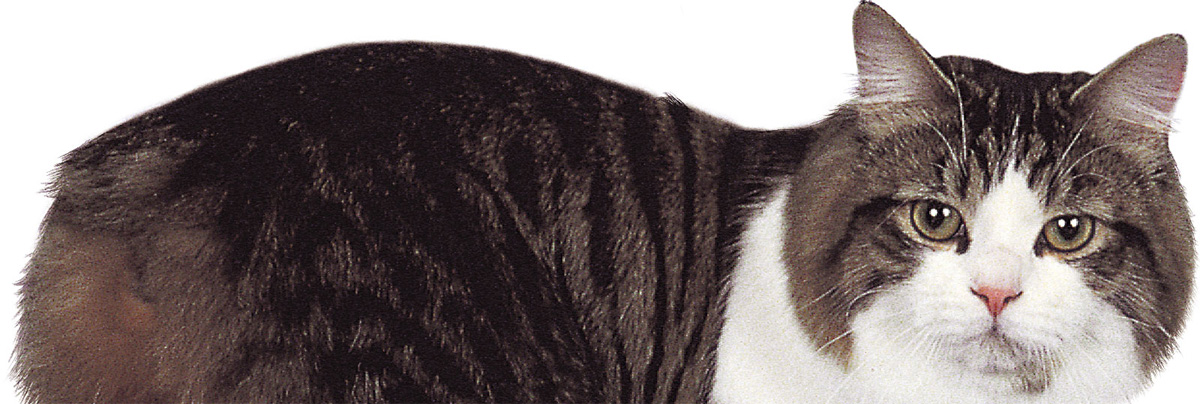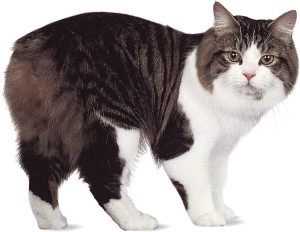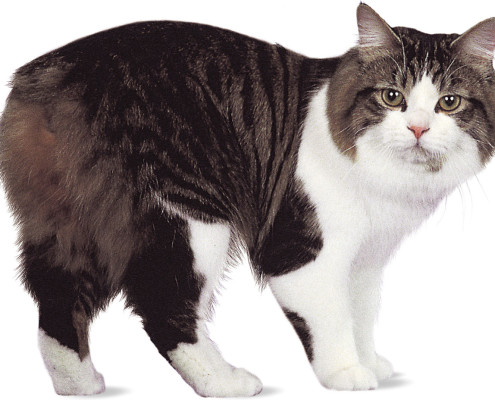Cymric

Meoww!!
A naturally tailless, sweet cat, the Cymric loves to play and requires daily grooming of a double coat.
In 5 Words
- Placid
- Sweet
- Long-hair
- Loving
- Understanding
Snapshot
WEIGHT RANGE:
Male: large: >12 lbs.
Female: medium: 8-12 lbs.
EYE COLOR:
Amber, Copper, Green, Gold, Hazel, Orange, Yellow
EXPECTATIONS:
Longevity Range: 9-13 yrs.
Social/Attention Needs: Moderate
Tendency to Shed: High
COAT:
Length: Long
Characteristics: Straight
Colors: White, Blue, Black, Red, Cream, Silver, Tortoiseshell, Bluecream, Brown
Pattern: Solid Color, Tortoiseshell, Bicolor, Tricolor/Calico, Tabby, Ticking, Smoke, Shaded
Less Allergenic: No
Overall Grooming Needs: High
CLUB RECOGNITION:
Cat Association Recognition:
ACFA , TICA
Prevalence: Rare

Characteristics
Learn About the Cymric
They Cymric got its name from the word “Cymru,” which is the traditional or indigenous name for “being of, or from, Wales.” Its long-haired, tail-less traits began as spontaneous mutations among the domestic Manx population on the island of Wales in the mid-twentieth century. Over time, some short-haired tail-less Manx cats had long-haired kittens among their litters, most of which were considered not true to type for the Manx breed. However, some Manx breeders became intrigued by these longer-haired versions of their tail-less cats.
The first officially recorded North American Cymric cat was born in Canada in the 1960s. In the latter part of that decade, breeders of Manx cats in America began to focus on the occasional long-haired kittens in their litters as being interesting, rather than simply something to neuter and place only in pet homes. The long-haired gene is recessive to the short-haired gene, which made it necessary to introduce outcrosses of long-haired, fully-tailed cats into Manx breeding programs in order to consistently produce the long-haired variety. Introduction of these outcrosses widened the gene pool and strengthened the type of the Cymric, or what we now call the long-haired Manx.
This highly unusual tail-less cat quickly gained popularity among cat lovers. However, it took many years for the Cymric to become recognized by purebred cat registry associations. The Manx was recognized in the 1920s, but the Cymric was not really developed until the 1960s and did not begin to gain popularity until the mid-1970s. The Cymric is best known in North America and Great Britain, although it is still an uncommon cat. It still has not been officially recognized in the United Kingdom for purebred registry. Today, in America, the Cymric is officially recognized as and considered to be a long-haired Manx, rather than a separate breed.
The mature Manx with all its rounded contours reminds one of a bowling ball. It is a round, heavy cat of medium size. Its primary feature is its lack of a tail. Not all kittens are born tailless. The ideal Manx has a rounded rump with just a dimple where the tail would have been however some have short stubby tails and some are born with full length tails. But the intelligent Manx is far more than just a cat without a tail! Its hind legs are long than the front legs so the rump is raised in the air. In days gone by, some people thought they saw a hopping gait and this, combined with the longer hind legs and lack of tail, gave rise to the moniker of ‘bunny cat’. These charming cats claim an origin from the Isle of Man and come in two coat lengths: the shorthair known as the Manx and the longhair known as the Cymric.
The personality of the Cymric has won a strong following despite the breeding challenges. Cymrics are intelligent, fun-loving cats, and they get along well with other pets, including dogs. Cymrics are particularly noted for their loyalty to their humans and enjoy spending quality time with them. As cats go, they can be easily taught tricks. Despite their playful temperament, they are gentle and nonaggressive. Their playful yet tractable dispositions are good for families with children.
Cymrics are powerful jumpers and if sufficiently motivated will manage to breach the most secure shelf. They are also fascinated by water, as long as you don’t dunk them in the nasty stuff. Perhaps this fascination comes from originating on a small piece of land surrounded by it.
Both pedigreed cats and mixed-breed cats have varying incidences of health problems that may be genetic in nature. Cymric are generally healthy, but the following diseases have been seen in the breed:
- Arthritis of the tailbone in cats with partial tails
- Corneal dystrophy, cloudiness that begins to develop when a kitten is approximately 4 months old
- Manx syndrome, a collection of birth defects that may include a spine that is too short, urinary tract defects, and problems with the bowels and digestion. The condition affects approximately 20 percent of Manx cats, most often rumpies, and usually shows up by the time a kitten is 4 months old, a good reason to wait until that age before bringing a Manx kitten home.
The sumptuous coat of Cymrics will make you want to hug and cuddle them all the time. Their fur is dense and well-padded. The toes and ears have impressive tufts. Overall, a Cymrics coat feels soft, smooth and silky. As in most cats, the winter coat will be heavier and longer. They do need grooming, but less than other longhair breeds such as, for example, the Persian. It is so because a Cymric’s fur is pretty resistant to matting. Twice a week grooming can be quite enough. However, in shedding periods, grooming has to be done daily.






